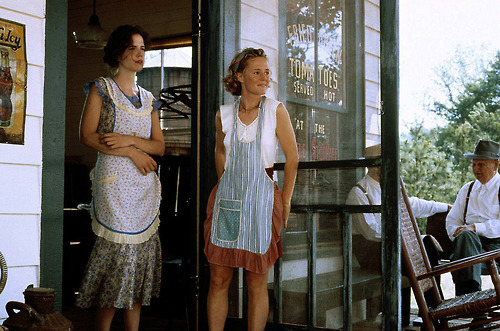
A Moment of Stillness in a Turbulent Story
Among the most visually peaceful and spiritually resonant scenes in Fried Green Tomatoes is the river baptism. Amid a story filled with tragedy, social rebellion, and loss, this brief but powerful moment provides a rare sense of quiet sanctity. Ruth’s baptism, conducted by a preacher with a small congregation watching, marks more than a religious rite—it is a turning point for both Ruth and Idgie, and a metaphor for emotional and personal renewal.
This scene doesn’t just move the plot forward. It carries the emotional weight of past grief, present faith, and future transformation.
Ruth’s Return to Faith—And Herself
When Ruth is baptized, she is not simply following religious convention. Her action is a deliberate return to a part of herself she thought she had lost. Having endured abuse at the hands of Frank Bennett, Ruth emerges from her marriage broken, her faith deeply shaken. The warm, sincere version of Christianity she once believed in has been corrupted by the cruelty she experienced.
The river, wide and calm, offers her something the church could not: redemption without judgment. It is not about public spectacle. It is about personal reclamation.
As she is dipped backward into the water and pulled gently back to the surface, the symbolism is clear. This is a woman who is letting go of her old life—one defined by fear and submission—and choosing, consciously, to begin again. The river doesn’t change Ruth into someone new. It restores her to herself.
Idgie Watching—On the Shore, But Deeply Involved

Idgie, ever the skeptic, stands on the edge, distant in belief but present in body. She does not partake in the ceremony. She does not speak the prayers. But she is there, watching with quiet intensity.
It’s a deeply meaningful visual: Ruth in white, surrounded by people of faith; Idgie in dark clothes, barefoot in the grass, arms crossed—separate but emotionally tethered.
For Idgie, who has long rejected religion since the death of her beloved brother Buddy, this moment is not just about Ruth’s belief—it’s about love. She cannot accept the institutional church, but she can accept Ruth’s need for spiritual healing. She doesn’t need to agree. She just needs to be there.
And she is.
Symbolism of Water: Cleansing and Reclaiming
Water, in spiritual literature and cinematic language, often symbolizes cleansing, transformation, and new beginnings. In Fried Green Tomatoes, the river represents something far more intimate than church walls can provide. It is untouched by politics, unmarked by judgment. It is wild and free—like Idgie—and yet healing and sacred—like Ruth’s quiet faith.
For Ruth, the river is the only place she can begin again. For Idgie, it is the only kind of faith she can accept: one that flows, not confines. One that liberates, not controls.
This scene is where the symbolic heart of the film becomes most visible. The line between belief and rebellion, between tradition and change, softens. The river holds them both.
A Private Vow Between Two Women
Though no explicit dialogue spells it out, the baptism scene reads like a vow between Ruth and Idgie. Ruth is making a commitment to life again—to faith, yes, but also to a future. And Idgie, by bearing witness, silently commits to being part of that future, even if she cannot speak its spiritual language.
Their relationship, long coded with emotional intimacy, takes on a new sacredness here. In the presence of community and nature, without the need for confession or ceremony, they make a kind of promise: to walk beside each other, through belief and doubt, through grief and joy.
This is what makes the scene one of the most emotionally stirring in the film. It is not only about Ruth’s rebirth. It is about Idgie’s quiet acceptance—that loving someone means honoring what heals them, even if it’s not your path.
Contrasting the Baptism with Other Losses
The beauty of the baptism is made more poignant by the losses that bookend it. Earlier, Idgie lost Buddy, a loss that shattered her innocence and turned her against religion. Later, she will lose Ruth. The baptism is the moment in between, where something is gained, not taken.
It is Ruth’s gesture of reclaiming peace before death enters her story. It is Idgie’s chance to witness healing before she must confront loss again.
For the viewer, this moment is like an exhale between storms. A spiritual interlude. And its impact lasts long after the scene ends.
Ninny’s Perspective: The Spiritual Thread in the Storytelling
In the present-day frame of the film, Ninny tells this story with a reverence that hints at how much this baptism meant—not just as an event, but as a symbol. To Evelyn, who is searching for her own transformation, the image of Ruth walking out of the river—reborn in body and spirit—is more than just a tale. It’s a reminder that it is never too late to choose life again.
And when Evelyn later begins to reinvent herself—declaring “Tawanda!” in the parking lot, asserting her space in the world—she is performing her own kind of baptism. Not in water, but in defiance.
Ninny’s retelling makes clear: rebirth is not limited to religion. It can be any moment you decide to begin again.
A Scene of Universal Resonance
Though deeply Southern and steeped in Christian symbolism, the baptism scene transcends its cultural context. It speaks to anyone who has needed a moment to reclaim themselves. Anyone who has stood in silence while someone they loved found healing. Anyone who has known that transformation is not about becoming someone else, but about remembering who you always were.
In this way, Ruth and Idgie’s moment at the river is not just for them. It’s for all of us.
Conclusion: The Sacred Flow of Love and Renewal
The river baptism in Fried Green Tomatoes is more than a moment of faith—it is a moment of profound human truth. It is about love without conditions, healing without answers, and rebirth without fanfare.
For Ruth, it is peace reclaimed. For Idgie, it is love without demand. For the viewer, it is the quiet reminder that transformation is always possible—even, and especially, in the middle of life’s hardest journeys.
In the river’s reflection, we see two women choosing one another again. And in the soft ripples of that water, we find a mirror for ourselves.
